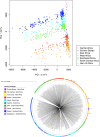Population dynamics and drug resistance mutations in Plasmodium falciparum on the Bijagós Archipelago, Guinea-Bissau
- PMID: 37072433
- PMCID: PMC10113324
- DOI: 10.1038/s41598-023-33176-1
Population dynamics and drug resistance mutations in Plasmodium falciparum on the Bijagós Archipelago, Guinea-Bissau
Abstract
Following integrated malaria control interventions, malaria burden on the Bijagós Archipelago has significantly decreased. Understanding the genomic diversity of circulating Plasmodium falciparum malaria parasites can assist infection control, through identifying drug resistance mutations and characterising the complexity of population structure. This study presents the first whole genome sequence data for P. falciparum isolates from the Bijagós Archipelago. Amplified DNA from P. falciparum isolates sourced from dried blood spot samples of 15 asymptomatic malaria cases were sequenced. Using 1.3 million SNPs characterised across 795 African P. falciparum isolates, population structure analyses revealed that isolates from the archipelago cluster with samples from mainland West Africa and appear closely related to mainland populations; without forming a separate phylogenetic cluster. This study characterises SNPs associated with antimalarial drug resistance on the archipelago. We observed fixation of the PfDHFR mutations N51I and S108N, associated with resistance to sulphadoxine-pyrimethamine, and the continued presence of PfCRT K76T, associated with chloroquine resistance. These data have relevance for infection control and drug resistance surveillance; particularly considering expected increases in antimalarial drug use following updated WHO recommendations, and the recent implementation of seasonal malaria chemoprevention and mass drug administration in the region.
© 2023. The Author(s).
Conflict of interest statement
The authors declare no competing interests.
Figures



Similar articles
-
Molecular surveillance of anti-malarial drug resistance genes in Plasmodium falciparum isolates in Odisha, India.Malar J. 2022 Dec 24;21(1):394. doi: 10.1186/s12936-022-04403-3. Malar J. 2022. PMID: 36566182 Free PMC article.
-
Increased prevalence of pfdhfr and pfdhps mutations associated with sulfadoxine-pyrimethamine resistance in Plasmodium falciparum isolates from Jazan Region, Southwestern Saudi Arabia: important implications for malaria treatment policy.Malar J. 2020 Dec 2;19(1):446. doi: 10.1186/s12936-020-03524-x. Malar J. 2020. PMID: 33267841 Free PMC article.
-
Prevalence of Plasmodium falciparum Molecular Markers of Antimalarial Drug Resistance in a Residual Malaria Focus Area in Sabah, Malaysia.PLoS One. 2016 Oct 27;11(10):e0165515. doi: 10.1371/journal.pone.0165515. eCollection 2016. PLoS One. 2016. PMID: 27788228 Free PMC article.
-
Genetic surveillance for monitoring the impact of drug use on Plasmodium falciparum populations.Int J Parasitol Drugs Drug Resist. 2021 Dec;17:12-22. doi: 10.1016/j.ijpddr.2021.07.004. Epub 2021 Jul 26. Int J Parasitol Drugs Drug Resist. 2021. PMID: 34333350 Free PMC article. Review.
-
The use of islands and cluster-randomized trials to investigate vector control interventions: a case study on the Bijagós archipelago, Guinea-Bissau.Philos Trans R Soc Lond B Biol Sci. 2021 Feb 15;376(1818):20190807. doi: 10.1098/rstb.2019.0807. Epub 2020 Dec 28. Philos Trans R Soc Lond B Biol Sci. 2021. PMID: 33357055 Free PMC article. Review.
Cited by
-
Oleuropein activates autophagy to circumvent anti-plasmodial defense.iScience. 2024 Mar 11;27(4):109463. doi: 10.1016/j.isci.2024.109463. eCollection 2024 Apr 19. iScience. 2024. PMID: 38562521 Free PMC article.
-
Monitoring molecular markers associated with antimalarial drug resistance in south-east Senegal from 2021 to 2023.J Antimicrob Chemother. 2025 Mar 3;80(3):828-839. doi: 10.1093/jac/dkaf006. J Antimicrob Chemother. 2025. PMID: 39846779
-
Genetic diversity of Plasmodium falciparum reticulocyte binding protein homologue-5, which is a potential malaria vaccine candidate: baseline data from areas of varying malaria endemicity in Mainland Tanzania.Malar J. 2025 Jan 27;24(1):29. doi: 10.1186/s12936-025-05269-x. Malar J. 2025. PMID: 39871346 Free PMC article.
-
Oleuropein mediated autophagy begets antimalarial drug resistance.Front Microbiol. 2024 Aug 20;15:1453998. doi: 10.3389/fmicb.2024.1453998. eCollection 2024. Front Microbiol. 2024. PMID: 39228384 Free PMC article.
-
Protocol for a cluster randomised placebo-controlled trial of adjunctive ivermectin mass drug administration for malaria control on the Bijagós Archipelago of Guinea-Bissau: the MATAMAL trial.BMJ Open. 2023 Jul 7;13(7):e072347. doi: 10.1136/bmjopen-2023-072347. BMJ Open. 2023. PMID: 37419638 Free PMC article.
References
-
- World Malaria Report 2021. Geneva: World Health Organization; 2021. Licence: CC BY-NC-SA 3.0 IGO.
-
- Geneva: World Health Organization; 2022 (WHO/UCN/GMP/2022.01 Rev.2). License: CC BY-NC-SA 3.0 IGO. WHO Guidelines for malaria - 3 June 2022. http://apps.who.int/bookorders. (2022).
Publication types
MeSH terms
Substances
Grants and funding
LinkOut - more resources
Full Text Sources
Medical

